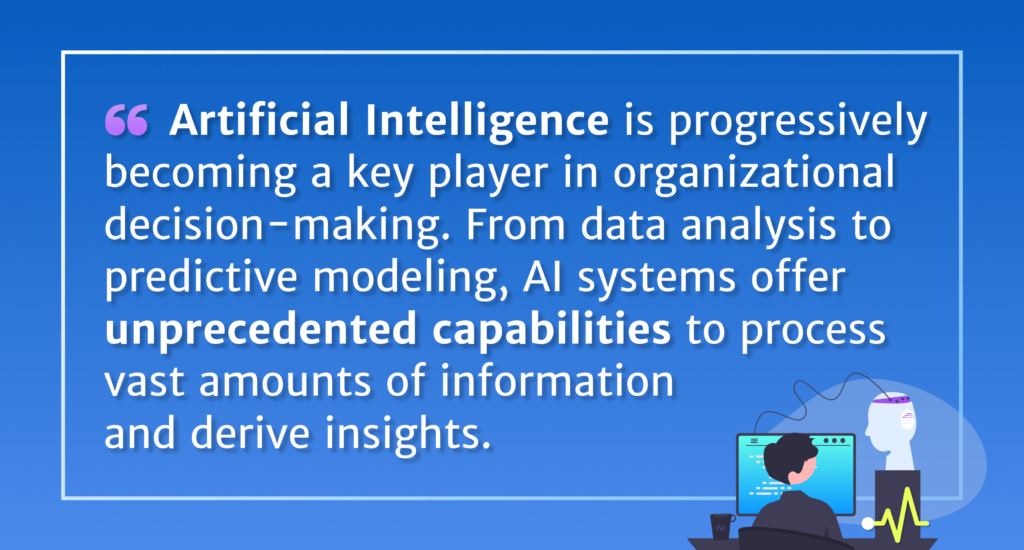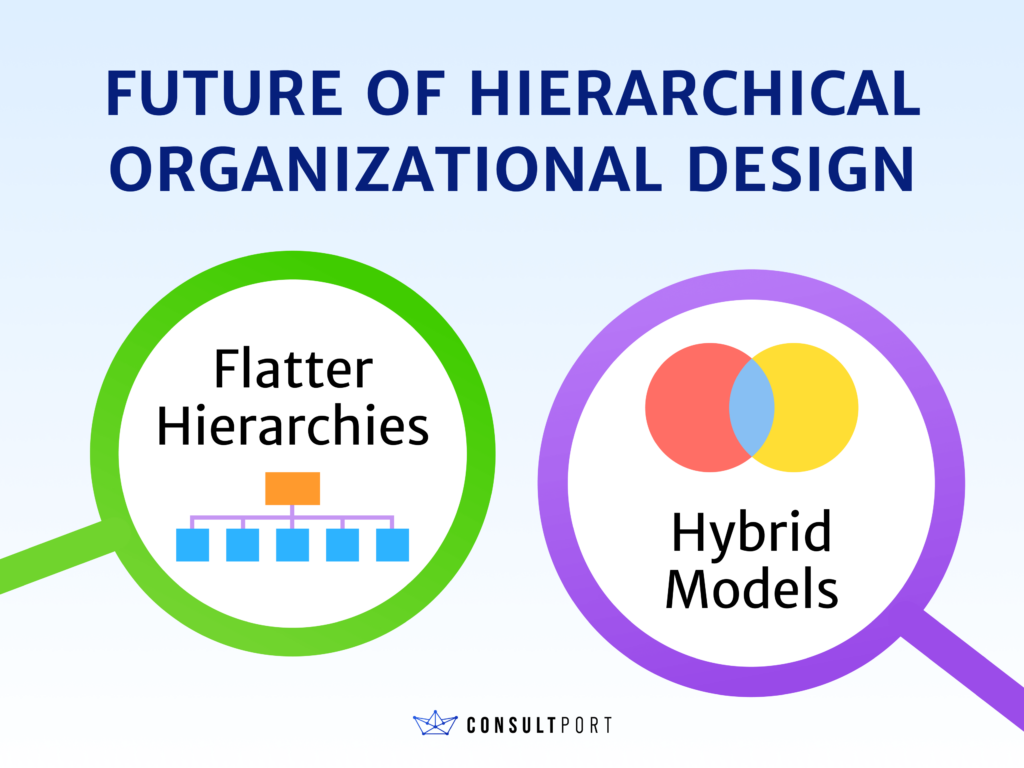Grand Designs: Building a Modern Business Hierarchy
Blog Categories:
Published:
December 10, 2023
Reading Time:
6 minutes

In the intricate architecture of organisational design, the concept of hierarchy design is a notion that turns up again and again. The structure of authority and responsibility within a company profoundly influences its operations, culture, and ability to achieve strategic objectives.
This blog post aims to lay out the critical elements of organisational design, specifically focusing on understanding and navigating challenges, assessing the impact of technology, and contemplating the future of hierarchical structures in modern business.
This blog post aims to lay out the critical elements of organisational design, specifically focusing on understanding and navigating challenges, assessing the impact of technology, and contemplating the future of hierarchical structures in modern business.
Understanding Organizational Hierarchy
Organizational hierarchy is the spine of a company's structure. It establishes a chain of command, delineating levels of authority and responsibility.
This section will delve into the significance of organizational hierarchy design, outlining how it streamlines decision-making, clarifies reporting relationships, and provides a framework for employees to understand their roles within the broader context of the company.
Therefore, a clear hierarchy fosters transparency and allows individuals to set realistic career goals.
Understanding these dynamics is pivotal for maintaining a cohesive and well-informed workforce.
This section will delve into the significance of organizational hierarchy design, outlining how it streamlines decision-making, clarifies reporting relationships, and provides a framework for employees to understand their roles within the broader context of the company.
- The Levels of Hierarchy:
Therefore, a clear hierarchy fosters transparency and allows individuals to set realistic career goals.
- Hierarchical Communication Dynamics:
Understanding these dynamics is pivotal for maintaining a cohesive and well-informed workforce.
KEY TAKEAWAYS
- Importance of Organizational Hierarchy Design: Organizational hierarchy establishes a chain of command, delineating levels of authority and responsibility. The significance of organizational hierarchy is that it streamlines decision-making, clarifies reporting relationships, and provides a framework for employees to understand their roles within the broader context of the company.
- Challenges of a Hierarchical Structure: Some common issues associated with hierarchical structures, such as bureaucracy, communication bottlenecks, and limited agility. These challenges can impede innovation, hinder employee engagement, and potentially stifle adaptability.
- The Impact of Technology on Hierarchical Structures: The digital age has ushered in transformative changes, influencing every facet of business, including organizational design. From the rise of remote work to the integration of AI in decision-making processes, technology is reshaping the dynamics of authority and communication.
- Future of Hierarchical Organizational Design: Companies must contemplate how hierarchical design might morph to meet the demands of a rapidly changing business landscape. From flatter hierarchies to hybrid models, companies can utilize emerging trends and potential innovations.
Challenges of a Hierarchical Structure
While hierarchy brings order, it also poses challenges. This section will dissect common issues associated with hierarchical structures, such as bureaucracy, communication bottlenecks, and limited agility.
These challenges can impede innovation, hinder employee engagement, and potentially stifle adaptability in today's dynamic business environment.
Breaking Down Silos: Hierarchical structures, while providing order, often inadvertently lead to silos—isolated departments operating independently. Silos hinder collaboration and innovation by creating barriers between teams and limiting the exchange of ideas and information.
Recognizing the detrimental effects of silos is essential for organizations aiming to foster a more interconnected and collaborative work environment.
To overcome silos, organizations must implement specific strategies. Encouraging cross-functional collaboration, fostering open communication channels, and establishing shared goals help break down departmental barriers. Creating a culture that values teamwork and knowledge-sharing is vital in unleashing the full potential of a diverse and collaborative workforce. Navigating Power Dynamics: An additional aspect to consider within the challenges of a hierarchical structure is the complex landscape of power dynamics.
The potential issues arising from power imbalances or struggles for influence can significantly impact employee morale. Understanding these dynamics is crucial for organizations that maintain a healthy and productive workplace culture.
Organizations can navigate power dynamics by promoting transparency in decision-making processes, establishing clear lines of communication, and providing opportunities for employee feedback.
Implementing leadership training that emphasizes emotional intelligence and inclusive decision-making can contribute to a healthier power dynamic within the organization.
How significantly technology will impact traditional hierarchical structures is still to be determined; from the rise of remote work to the integration of AI in decision-making processes, technology is reshaping the dynamics of authority and communication.

Instead, workforces are spread across different locations, leading to the emergence of distributed teams.
The implications of remote work on hierarchical structures are significant. With physical distances and the absence of a centralized office, hierarchies may need to adapt to ensure effective communication, collaboration, and the management of teams that are no longer physically co-located.

The intersection of AI and hierarchy brings substantial benefits. AI can enhance decision-making by providing data-driven insights, automating routine tasks, and improving overall efficiency. It can assist leaders in making more informed and strategic choices, particularly in complex and dynamic environments.
However, relying on automated systems for strategic decisions may lead to a need for more human intuition and contextual understanding.

As businesses evolve, so too must their organizational structures. Looking toward the future, organizations must contemplate how hierarchical design might morph to meet the demands of a rapidly changing business landscape.
Companies can utilize emerging trends and potential innovations from flatter hierarchies to hybrid models.
Flatter Hierarchies: In pursuing organizational efficiency and increased agility, some companies are moving towards flatter hierarchies. This means reducing the number of hierarchical levels and layers within the organizational structure. The aim is to streamline decision-making, improve communication, and empower employees at various levels to take on more responsibilities.
Flatter hierarchies empower employees at different levels to make decisions promptly, as there are fewer layers of approval. With fewer levels, communication becomes more direct and transparent, fostering a better understanding of goals and expectations.
Hybrid Models: Hybrid organizational models seek to combine the strengths of traditional hierarchical structures with more collaborative and flexible elements. This approach aims to strike a balance between maintaining order and fostering adaptability in the face of changing business landscapes.
Hybrid models retain essential elements of hierarchy to ensure a transparent chain of command, accountability, and defined roles. By incorporating collaborative elements, these models encourage innovation and creative problem-solving.
These challenges can impede innovation, hinder employee engagement, and potentially stifle adaptability in today's dynamic business environment.
Breaking Down Silos: Hierarchical structures, while providing order, often inadvertently lead to silos—isolated departments operating independently. Silos hinder collaboration and innovation by creating barriers between teams and limiting the exchange of ideas and information.
Recognizing the detrimental effects of silos is essential for organizations aiming to foster a more interconnected and collaborative work environment.
To overcome silos, organizations must implement specific strategies. Encouraging cross-functional collaboration, fostering open communication channels, and establishing shared goals help break down departmental barriers. Creating a culture that values teamwork and knowledge-sharing is vital in unleashing the full potential of a diverse and collaborative workforce. Navigating Power Dynamics: An additional aspect to consider within the challenges of a hierarchical structure is the complex landscape of power dynamics.
The potential issues arising from power imbalances or struggles for influence can significantly impact employee morale. Understanding these dynamics is crucial for organizations that maintain a healthy and productive workplace culture.
Organizations can navigate power dynamics by promoting transparency in decision-making processes, establishing clear lines of communication, and providing opportunities for employee feedback.
Implementing leadership training that emphasizes emotional intelligence and inclusive decision-making can contribute to a healthier power dynamic within the organization.
Impact of Technology on Hierarchical Structures
The digital age has ushered in transformative changes, influencing every facet of business, including organizational design.How significantly technology will impact traditional hierarchical structures is still to be determined; from the rise of remote work to the integration of AI in decision-making processes, technology is reshaping the dynamics of authority and communication.

Remote Work and Distributed Teams:
The rise of remote work has revolutionized the traditional concept of a centralized office with a clear hierarchy. Employees are no longer confined to a physical workspace, challenging the notion of a structured and centralized command center.Instead, workforces are spread across different locations, leading to the emergence of distributed teams.
The implications of remote work on hierarchical structures are significant. With physical distances and the absence of a centralized office, hierarchies may need to adapt to ensure effective communication, collaboration, and the management of teams that are no longer physically co-located.
AI and Decision-Making:
Artificial Intelligence (AI) is progressively becoming a key player in organizational decision-making. From data analysis to predictive modeling, AI systems offer unprecedented capabilities to process vast amounts of information and derive insights. This transformation impacts how decisions are made at different levels within hierarchical structures.
The intersection of AI and hierarchy brings substantial benefits. AI can enhance decision-making by providing data-driven insights, automating routine tasks, and improving overall efficiency. It can assist leaders in making more informed and strategic choices, particularly in complex and dynamic environments.
However, relying on automated systems for strategic decisions may lead to a need for more human intuition and contextual understanding.
Future of Hierarchical Organizational Design

As businesses evolve, so too must their organizational structures. Looking toward the future, organizations must contemplate how hierarchical design might morph to meet the demands of a rapidly changing business landscape.
Companies can utilize emerging trends and potential innovations from flatter hierarchies to hybrid models.
Flatter Hierarchies: In pursuing organizational efficiency and increased agility, some companies are moving towards flatter hierarchies. This means reducing the number of hierarchical levels and layers within the organizational structure. The aim is to streamline decision-making, improve communication, and empower employees at various levels to take on more responsibilities.
Flatter hierarchies empower employees at different levels to make decisions promptly, as there are fewer layers of approval. With fewer levels, communication becomes more direct and transparent, fostering a better understanding of goals and expectations.
Hybrid Models: Hybrid organizational models seek to combine the strengths of traditional hierarchical structures with more collaborative and flexible elements. This approach aims to strike a balance between maintaining order and fostering adaptability in the face of changing business landscapes.
Hybrid models retain essential elements of hierarchy to ensure a transparent chain of command, accountability, and defined roles. By incorporating collaborative elements, these models encourage innovation and creative problem-solving.
Unlocking Organizational Potential
In the intricate realm of contemporary business, organizational design stands as a pivotal factor for success, a truth acknowledged by Consultport. Understanding the indispensable role of a tailor-made structure in accordance with your business goals, our seasoned consultants contribute industry-specific expertise to optimize your organizational hierarchy.
We effectively tackle challenges such as communication and innovation and provide targeted solutions to elevate operational efficiency. Our consultants, in embracing technology, construct agile hierarchies capable of adapting to dynamic changes.
Furthermore, in the pursuit of future-proofing your design, we offer insights into the evolving organizational landscapes, facilitating the anticipation of changes and the adoption of innovative structures for sustained success.
Our results-driven approach sets Consultport apart, collaborating with your team to implement strategies that yield measurable success.
In the dynamic field of organizational design, expert guidance is not just an advantage; it's a necessity. Choose Consultport for a transformative journey towards optimal organizational and hierarchy design.
We effectively tackle challenges such as communication and innovation and provide targeted solutions to elevate operational efficiency. Our consultants, in embracing technology, construct agile hierarchies capable of adapting to dynamic changes.
Furthermore, in the pursuit of future-proofing your design, we offer insights into the evolving organizational landscapes, facilitating the anticipation of changes and the adoption of innovative structures for sustained success.
Our results-driven approach sets Consultport apart, collaborating with your team to implement strategies that yield measurable success.
In the dynamic field of organizational design, expert guidance is not just an advantage; it's a necessity. Choose Consultport for a transformative journey towards optimal organizational and hierarchy design.
Share This Story, Choose Your Platform!



